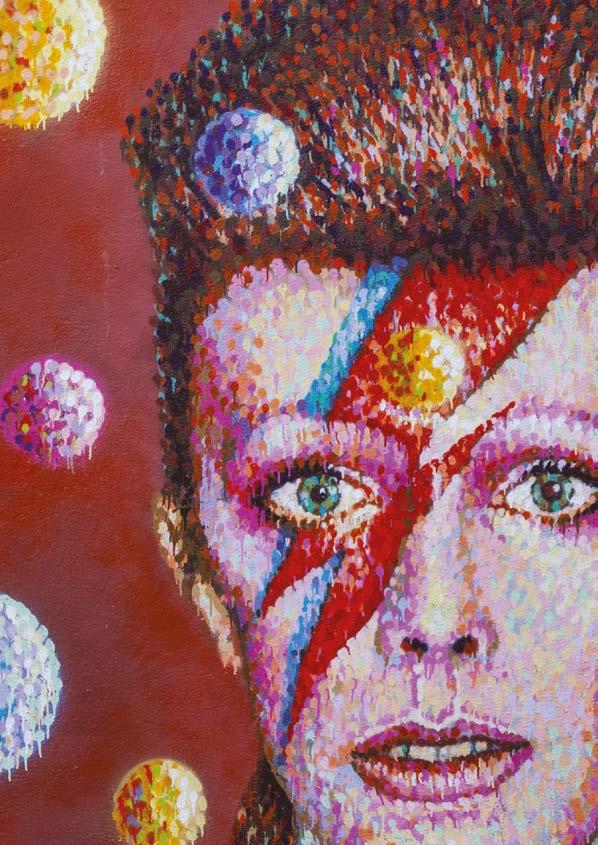
4 minute read
David Bowie: The Man Who Fell to Earth and Changed the Face of it
DAV ID BOWIE THE MAN WHO FELL TO EARTH AND CHANGED THE FACE OF IT

Advertisement
I will be the first to admit that other than the notes of “Hero’s” and “Let’s Dance”, of which, following their 1977 and 1983 exculpations, youths entered the world knowing the lyrics to, my first true interaction with David Bowie came through his featuring on “Under Pressure”, a title more syndicated with his peers of Queen than the Starman, and his 1976 playing of Thomas Jerome Newton in “The Man Who Fell to Earth”. It was through the latter of these that I understood what it was that the boy from Brixton had that enamoured so many. So began my journey into the world and work of David Bowie.
His career was chameleon-like, marked by constant innovation and reinvention, the man who fell to earth buttressed the way for experimentation in fashion, music and gender. His egos such as Ziggy Stardust; the Thin White Duke and Aladdin Sane not only constantly shifted the public perception of Bowie, it licensed peregrination for others. Forasmuch an alien presence in pop music, years before non-binary identities were absorbed into the mainstream, Bowie’s fluidity and androgyny was a valuable and recherché endowment.
Speaking to BBC’s Tonight programme in support of his organisation, “The Society for The Prevention of Cruelty to Long-Haired Men”, Bowie declared; “I think we all like long hair and I don’t see why other people should persecute us because of it”. Beyond a male’s choice in coiffure, accepting others choices is something that, even in our current climate, society seems to be lacking and, in a civilization where having the gumption to challenge social normality still puts fear into many, Bowie had it in buckets. Although not a part of the punk scene, Bowie’s drifting from societal formula embodied a similar sense of the punk questioning of convention. His anarchistic and ostentatious presentation of gender tested the virile, mainstream ideas associated to cisgender men, offering others avenues of self-exploration. “I’m gay and always have been, even when I was David Jones”. It was in the January 22, 1972 edition of the English Publication “Melody Maker”, shortly after the December release of “Hunky Dory” and before his entrance into full stardom, that Bowie promulgated these words. Considering homosexuality had only been decriminalized in 1967 and the stigma that was still attached to it, Bowie’s move was ambitious and risky. Despite not being the first UK mainstream musician to come out, following Dusty Springfield in 1970, his declaration came just after his marriage to Angie Bowie and fathering his first son Duncan and sparked much intrigue. The juxtaposition of his dogmatic position as a new husband and father with the persona portrayed through his songs such as “Queen Bitch”, a chronicle from the perspective of a participant in gay life, meant that Bowie was the first musician to truly contextualize pop through LGBT identity. Later that same year, Bowie scored a UK hit with the pansexual knowingness of “John, I’m Only Dancing”, considered too idiosyncratic for the American market. Withheld US release of “John, I’m Only Dancing” continued until the 1976 collection “ChangesOneBowie” and it was during this press run, with the ever-controversial publication “Playboy”, that Cameron Crowe nudged Bowie to provide the response “It’s true, I am bisexual. But I can’t hide the fact that I’ve used it very well,” reposting a smattering of queries but promoting others. By this point in his career, Bowie’s waves were to be felt far beyond his own actions. Chaperoning the UK music scene through its post-Beatles-mania slump, Bowie offered us songs such as Lou Reed’s first hit; the Bowie-produced “Walk on The Wild Side”, the anecdote of Warhol’s colossally queer Factory. As well as igniting our interest through revolutionizing a forbidding balladeer into the pre-eminent Technicolor; Elton John, adding to his securing the Elektra Records singings of Jobiath and Queen. In conjunction with his metamorphic display of gender, Bowie’s bending genre offered him R&B radio success with hits such as “Young Americans” and “Fame”. Using his amorphous genre, Bowie bastioned the yoking of the unequivocally prosperous soul with the melodies of furtive gay dance halls, his seat on the outsider’s entitling him to build bridges between the multifarious yet mellifluous genres. So whilst we will never again be gifted pristine music from the Starman, Bowie’s legacy lives far beyond his years, engaging ideas that most, in 2017, haven’t even begun to think about. So even when, in 1971, Bowie wrote the lyrics “turn and face the strange”, whichever of his personas he chose to narrate it, we can be sure that we were the recipients of it. Romilly J (Upper Sixth)











